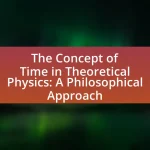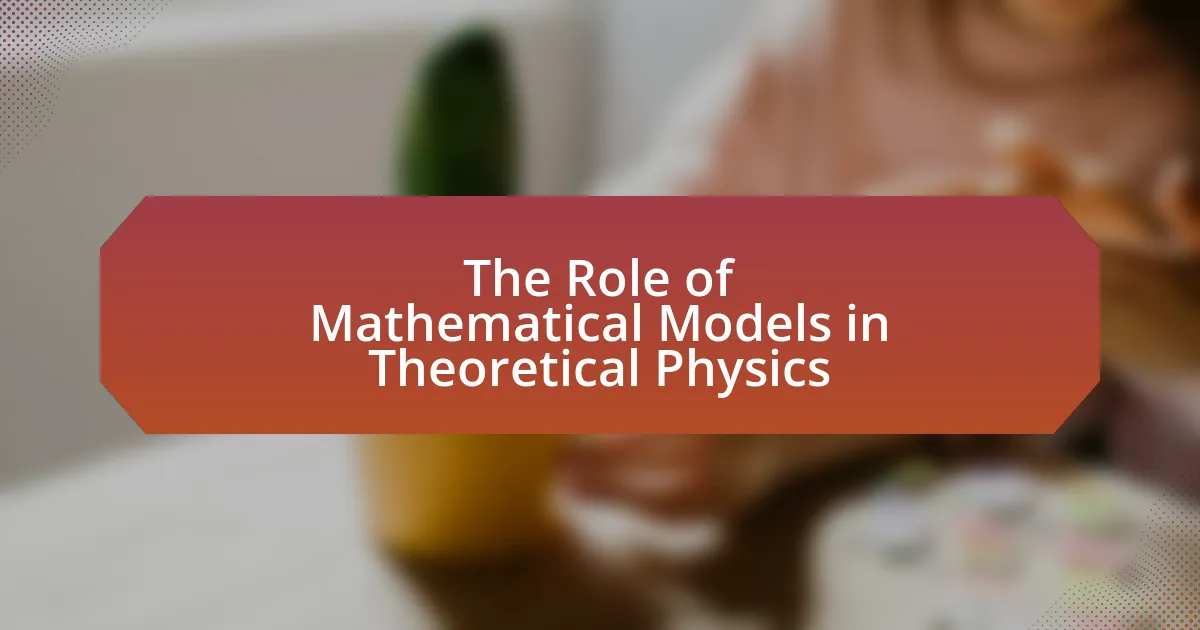The article examines the challenges of unifying General Relativity and Quantum Mechanics, two fundamental theories in physics that describe the universe at vastly different scales. General Relativity, formulated by Albert Einstein, explains gravity as the curvature of spacetime influenced by mass and energy, while Quantum Mechanics focuses on the probabilistic behavior of particles at atomic and subatomic levels. The article outlines key principles of both theories, highlights their incompatibilities, and discusses leading unification theories such as string theory and loop quantum gravity. It also addresses the philosophical implications of unification, the ethical considerations arising from advancements in theoretical physics, and practical steps researchers can take to further explore this complex relationship.
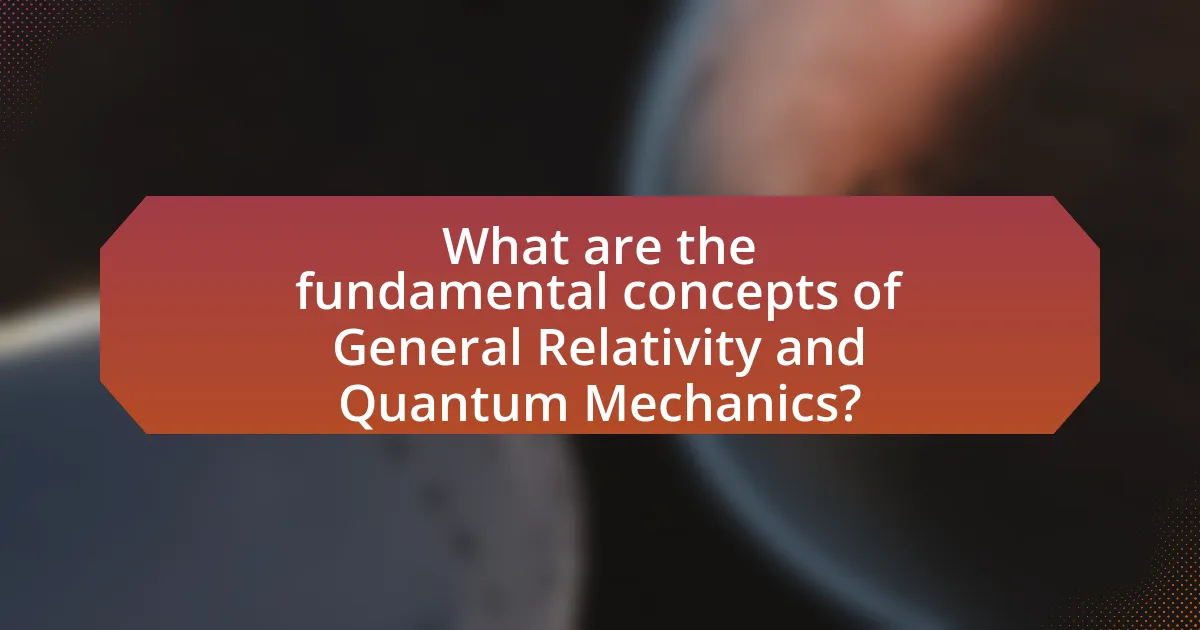
What are the fundamental concepts of General Relativity and Quantum Mechanics?
The fundamental concepts of General Relativity include the curvature of spacetime caused by mass and energy, which describes gravity as a geometric property rather than a force. This theory, formulated by Albert Einstein in 1915, posits that massive objects like planets and stars warp the fabric of spacetime, influencing the motion of other objects. In contrast, Quantum Mechanics focuses on the behavior of particles at the atomic and subatomic levels, emphasizing principles such as wave-particle duality, uncertainty, and quantization of energy levels. This framework, developed in the early 20th century through contributions from scientists like Max Planck and Niels Bohr, describes how particles exist in probabilistic states rather than definite positions. The challenge of unifying these two theories arises from their fundamentally different descriptions of nature: General Relativity operates on a macroscopic scale, while Quantum Mechanics governs the microscopic realm, leading to conflicts in understanding phenomena like black holes and the early universe.
How does General Relativity describe gravity?
General Relativity describes gravity as the curvature of spacetime caused by mass and energy. According to Einstein’s theory, massive objects like planets and stars warp the fabric of spacetime around them, leading to the phenomenon we perceive as gravitational attraction. This is mathematically represented by the Einstein field equations, which relate the geometry of spacetime to the distribution of mass and energy. The theory has been validated through numerous experiments, such as the observation of light bending around massive objects during a solar eclipse, confirming that gravity is not a force in the traditional sense but a geometric property of spacetime itself.
What are the key principles of General Relativity?
The key principles of General Relativity include the equivalence principle, the curvature of spacetime, and the influence of mass on the geometry of spacetime. The equivalence principle states that the effects of gravity are indistinguishable from acceleration, meaning that locally, the laws of physics in a gravitational field are the same as those in an accelerating frame. The curvature of spacetime, described by Einstein’s field equations, illustrates how mass and energy warp the fabric of spacetime, leading to the phenomenon we perceive as gravity. This principle is supported by empirical evidence, such as the bending of light around massive objects, confirmed during the solar eclipse of 1919, which validated Einstein’s predictions.
How does spacetime curvature relate to gravity in General Relativity?
Spacetime curvature is the fundamental concept in General Relativity that describes how gravity operates. According to Einstein’s theory, massive objects like planets and stars warp the fabric of spacetime around them, creating curvature that influences the motion of other objects. This curvature is mathematically represented by the Einstein field equations, which relate the geometry of spacetime to the distribution of mass and energy. The proof of this relationship is evident in phenomena such as the bending of light around massive objects, observed during solar eclipses, and the precise orbits of planets, which align with predictions made by General Relativity.
What are the core principles of Quantum Mechanics?
The core principles of Quantum Mechanics include wave-particle duality, uncertainty principle, superposition, and entanglement. Wave-particle duality asserts that particles exhibit both wave-like and particle-like properties, as demonstrated in experiments like the double-slit experiment. The uncertainty principle, formulated by Werner Heisenberg, states that certain pairs of physical properties, such as position and momentum, cannot be simultaneously measured with arbitrary precision. Superposition allows quantum systems to exist in multiple states at once until measured, while entanglement describes a phenomenon where particles become interconnected, such that the state of one instantly influences the state of another, regardless of distance. These principles are foundational to understanding quantum behavior and have been validated through numerous experiments, including those confirming Bell’s theorem regarding entangled particles.
How do quantum states and superposition work?
Quantum states represent the complete information about a quantum system, encapsulating all possible outcomes of measurements. Superposition is a fundamental principle of quantum mechanics where a quantum system can exist simultaneously in multiple states until a measurement is made, collapsing it into one of the possible states. This phenomenon is exemplified by Schrödinger’s cat thought experiment, which illustrates a cat being both alive and dead until observed. The mathematical framework of quantum mechanics, specifically the wave function, describes these states and their probabilities, reinforcing the concept that quantum systems do not have definite properties until measured.
What role does uncertainty play in Quantum Mechanics?
Uncertainty plays a fundamental role in Quantum Mechanics by defining the limits of precision with which certain pairs of physical properties, such as position and momentum, can be simultaneously known. This principle, known as the Heisenberg Uncertainty Principle, states that the more accurately one property is measured, the less accurately the other can be determined. For example, if the position of a particle is known with high precision, its momentum becomes highly uncertain, and vice versa. This intrinsic uncertainty is not due to measurement limitations but is a fundamental characteristic of quantum systems, as demonstrated in experiments like the double-slit experiment, which illustrates wave-particle duality and the probabilistic nature of quantum states.
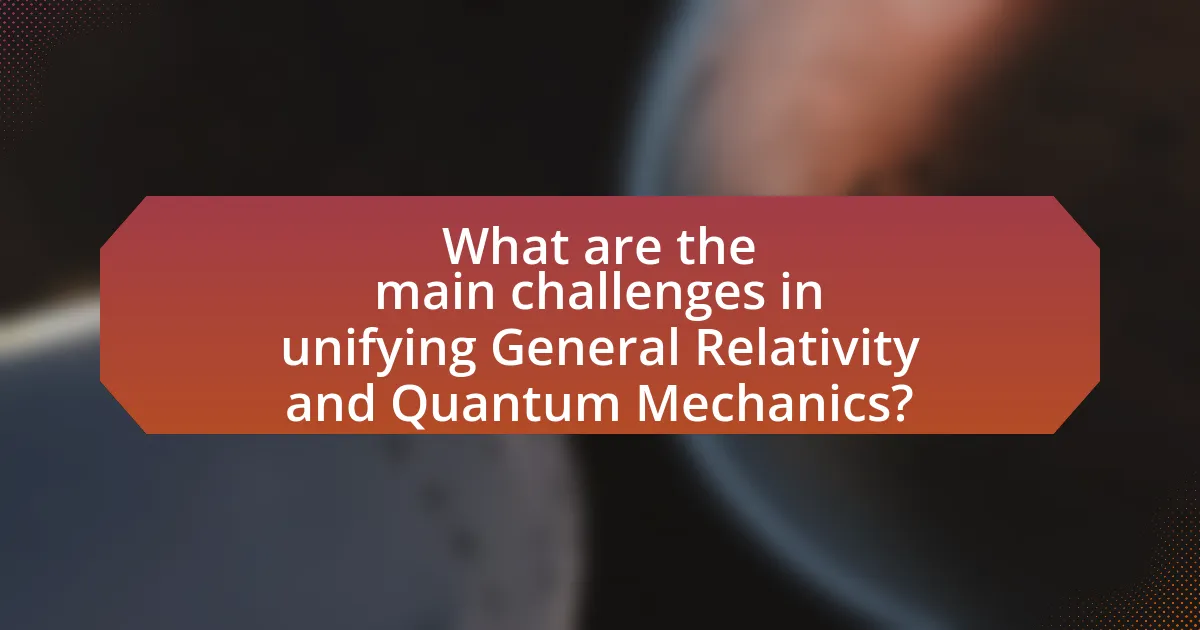
What are the main challenges in unifying General Relativity and Quantum Mechanics?
The main challenges in unifying General Relativity and Quantum Mechanics include the incompatibility of their fundamental principles, the lack of a coherent framework that integrates gravity with quantum forces, and the difficulties in reconciling the deterministic nature of General Relativity with the probabilistic nature of Quantum Mechanics. General Relativity describes gravity as the curvature of spacetime caused by mass, while Quantum Mechanics operates on discrete particles and probabilistic events. This fundamental difference creates significant obstacles in developing a unified theory, as evidenced by the failure of existing approaches like string theory and loop quantum gravity to provide a complete and experimentally validated framework.
Why is the incompatibility between the two theories significant?
The incompatibility between general relativity and quantum mechanics is significant because it hinders the development of a unified theory of physics that can accurately describe all fundamental forces. This incompatibility leads to unresolved questions about the nature of spacetime and the behavior of particles at the quantum level, which are essential for understanding the universe. For instance, phenomena such as black holes and the Big Bang challenge existing theories, as general relativity predicts singularities where quantum effects cannot be ignored. The lack of a coherent framework that integrates both theories limits advancements in theoretical physics and our comprehension of the universe’s fundamental workings.
What are the implications of this incompatibility for our understanding of the universe?
The incompatibility between general relativity and quantum mechanics implies that our current understanding of the universe is fundamentally incomplete. This discordance suggests that the laws governing large-scale structures, such as galaxies and black holes, do not align with those that dictate subatomic particles and their interactions. For instance, general relativity describes gravity as a curvature of spacetime, while quantum mechanics operates on probabilistic principles, leading to phenomena like superposition and entanglement. The failure to reconcile these theories indicates that a more comprehensive framework, such as quantum gravity, is necessary to fully explain the universe’s workings. This need for a unified theory highlights the limitations of existing models and drives ongoing research in theoretical physics, aiming to bridge the gap between the macroscopic and microscopic realms.
How does this challenge affect theoretical physics?
The challenge of unifying general relativity and quantum mechanics significantly impacts theoretical physics by hindering the development of a comprehensive framework that accurately describes all fundamental forces. This difficulty arises because general relativity governs large-scale phenomena, such as gravity, while quantum mechanics explains the behavior of particles at the smallest scales. The incompatibility between these two theories leads to unresolved questions about the nature of spacetime and the behavior of matter under extreme conditions, such as black holes and the Big Bang. For instance, attempts to formulate a theory of quantum gravity, such as string theory, highlight the complexities involved in reconciling these frameworks, illustrating the profound implications for our understanding of the universe.
What are the leading theories attempting to unify these concepts?
The leading theories attempting to unify general relativity and quantum mechanics include string theory, loop quantum gravity, and quantum gravity. String theory posits that fundamental particles are one-dimensional strings rather than point-like objects, allowing for a framework that incorporates both quantum mechanics and gravity. Loop quantum gravity, on the other hand, focuses on quantizing spacetime itself, suggesting that space is made up of discrete units. Quantum gravity aims to reconcile the principles of quantum mechanics with the geometric nature of general relativity, seeking a comprehensive theory that describes all fundamental forces. These theories are supported by ongoing research and mathematical formulations that attempt to bridge the gap between the macroscopic and microscopic realms of physics.
How does String Theory propose to bridge the gap?
String Theory proposes to bridge the gap between General Relativity and Quantum Mechanics by suggesting that fundamental particles are not point-like objects but rather one-dimensional strings that vibrate at different frequencies. This framework allows for the unification of gravity, described by General Relativity, with the other fundamental forces of nature, which are explained by Quantum Mechanics. The theory incorporates additional dimensions beyond the familiar four, which helps reconcile the mathematical inconsistencies that arise when attempting to merge these two domains. String Theory’s ability to provide a consistent quantum description of gravity supports its potential as a unifying theory, as evidenced by its predictions of phenomena such as black hole entropy and the behavior of particles at high energies.
What is Loop Quantum Gravity and how does it differ from String Theory?
Loop Quantum Gravity (LQG) is a theoretical framework that attempts to reconcile general relativity and quantum mechanics by quantizing spacetime itself, proposing that space is composed of discrete units or “quanta.” In contrast, String Theory posits that the fundamental constituents of the universe are one-dimensional strings rather than point-like particles, and it aims to unify all fundamental forces, including gravity, through higher-dimensional objects.
The key difference lies in their foundational approaches: LQG focuses on the geometry of spacetime and its quantization, while String Theory emphasizes the existence of additional dimensions and the vibrational modes of strings to explain particle interactions. LQG does not require extra dimensions, whereas String Theory typically requires ten or more dimensions for mathematical consistency.
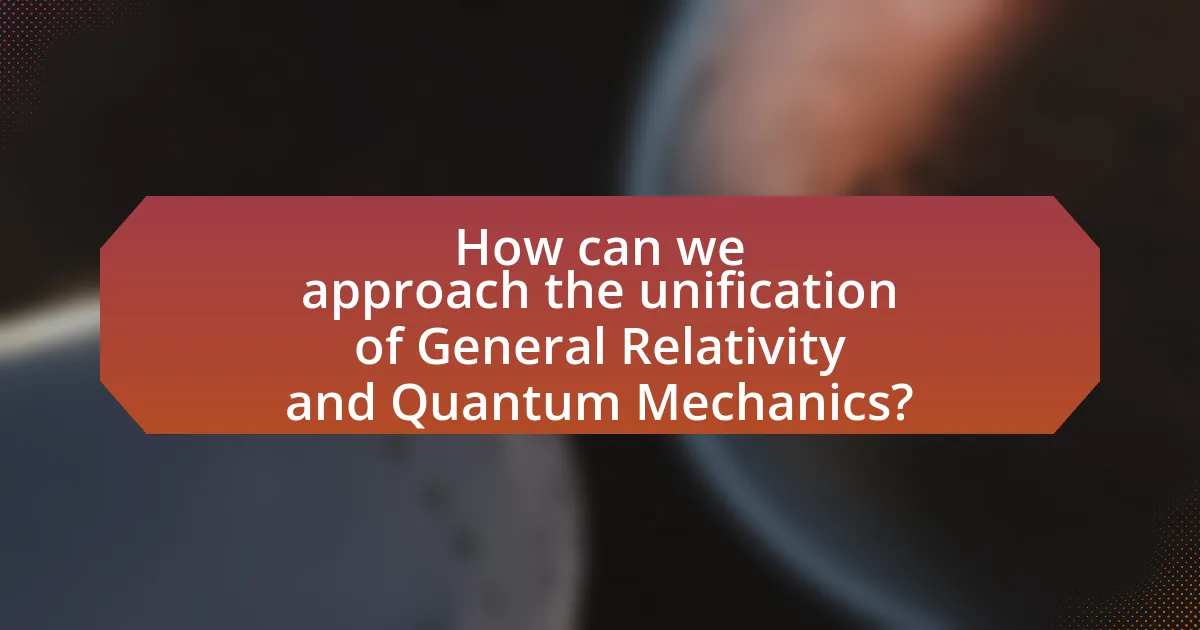
How can we approach the unification of General Relativity and Quantum Mechanics?
To approach the unification of General Relativity and Quantum Mechanics, researchers can explore theories such as string theory and loop quantum gravity. String theory posits that fundamental particles are one-dimensional strings, which can reconcile the principles of quantum mechanics with the curvature of spacetime described by General Relativity. Loop quantum gravity, on the other hand, attempts to quantize spacetime itself, suggesting that space is composed of discrete units. Both theories aim to provide a framework where the gravitational force is integrated with quantum forces, addressing the inconsistencies that arise when applying classical physics to subatomic scales. Historical attempts, such as the work of Albert Einstein and Niels Bohr, highlight the ongoing struggle to reconcile these two pillars of physics, emphasizing the need for a comprehensive theory that can accurately describe the universe at all scales.
What experimental evidence is needed to support unification theories?
Experimental evidence needed to support unification theories includes observations of phenomena that bridge the gap between general relativity and quantum mechanics. Specifically, evidence such as the detection of gravitational waves, which confirms predictions of general relativity, and their potential interactions with quantum systems, is crucial. Additionally, experiments that probe the behavior of particles at high energies, such as those conducted at the Large Hadron Collider, can provide insights into the unification of forces. Theoretical predictions, like those from string theory or loop quantum gravity, require experimental validation through precise measurements of cosmic microwave background radiation or tests of quantum entanglement in gravitational fields. These experimental results would substantiate the frameworks proposed for unification, demonstrating their applicability in real-world scenarios.
What current experiments are being conducted to test these theories?
Current experiments testing the theories of unifying General Relativity and Quantum Mechanics include the use of gravitational wave detectors, such as LIGO and Virgo, which aim to observe the effects of quantum fluctuations in spacetime. These detectors have already confirmed the existence of gravitational waves, providing insights into the behavior of massive objects and their interactions at quantum levels. Additionally, experiments involving quantum entanglement, such as those conducted by the Bell test experiments, are investigating the non-locality of quantum mechanics and its implications for spacetime. These experiments are crucial for understanding how quantum mechanics and general relativity can coexist and potentially be unified.
How do advancements in technology aid in this research?
Advancements in technology significantly aid research in unifying General Relativity and Quantum Mechanics by providing sophisticated computational tools and experimental techniques. High-performance computing allows researchers to simulate complex physical systems and analyze vast datasets, facilitating the exploration of theoretical models that bridge the two frameworks. For instance, advancements in quantum computing enable the processing of information in ways that classical computers cannot, potentially leading to new insights into quantum gravity. Additionally, technologies such as gravitational wave detectors and particle accelerators offer empirical data that can validate or challenge existing theories, thereby guiding the development of a unified theory. These technological innovations are crucial for addressing the intricate challenges posed by the reconciliation of these fundamental theories in physics.
What are the philosophical implications of unifying these theories?
The philosophical implications of unifying general relativity and quantum mechanics include a reevaluation of the nature of reality, causality, and the concept of determinism. Unification suggests that the fundamental forces of nature may be interconnected, challenging the classical view of separate domains for gravity and quantum phenomena. This interconnectedness raises questions about the nature of space and time, as well as the role of the observer in determining physical outcomes, which is a central theme in quantum mechanics. Furthermore, the potential for a unified theory could imply that our understanding of the universe is incomplete, necessitating a shift in philosophical perspectives regarding knowledge and the limits of scientific inquiry. The implications extend to ethical considerations in technology and the understanding of consciousness, as advancements in these theories could lead to profound changes in how humanity interacts with the universe.
How does unification affect our understanding of reality and existence?
Unification enhances our understanding of reality and existence by providing a coherent framework that reconciles the principles of general relativity and quantum mechanics. This reconciliation suggests that the fundamental forces of nature are interconnected, leading to a more comprehensive view of the universe. For instance, theories such as string theory propose that all particles are manifestations of one-dimensional strings, which implies a deeper unity underlying physical phenomena. This perspective challenges traditional notions of separate realms of physics, indicating that reality may be more interconnected than previously thought. The pursuit of unification also drives advancements in theoretical physics, as seen in the ongoing research efforts to develop a theory of quantum gravity, which aims to describe gravity within the quantum framework, further refining our understanding of existence itself.
What ethical considerations arise from advancements in theoretical physics?
Advancements in theoretical physics raise several ethical considerations, particularly regarding the implications of scientific discoveries on society and the environment. The development of technologies derived from theoretical physics, such as nuclear energy and quantum computing, necessitates careful evaluation of their potential risks, including environmental degradation and the proliferation of weapons. For instance, the Manhattan Project, which led to the creation of atomic bombs, highlights the ethical dilemmas associated with harnessing scientific knowledge for destructive purposes. Furthermore, advancements in theoretical physics can lead to socioeconomic disparities, as access to cutting-edge technologies may be limited to affluent nations or individuals, exacerbating global inequalities. These considerations underscore the need for responsible stewardship of scientific knowledge to ensure that advancements benefit humanity as a whole rather than posing threats or deepening divides.
What practical steps can researchers take to advance the unification of General Relativity and Quantum Mechanics?
Researchers can advance the unification of General Relativity and Quantum Mechanics by developing and testing theories that incorporate both frameworks, such as string theory and loop quantum gravity. These theories aim to reconcile the principles of gravity described by General Relativity with the probabilistic nature of quantum mechanics. For instance, string theory posits that fundamental particles are one-dimensional strings, which could unify all forces, including gravity, under a single framework. Additionally, researchers should conduct experiments that probe the quantum aspects of gravity, such as those involving black holes or gravitational waves, to gather empirical data that could support or refute these theories. Collaborative efforts across disciplines, including physics, mathematics, and computer science, can also facilitate the exploration of complex models and simulations that may reveal insights into the unification process.


